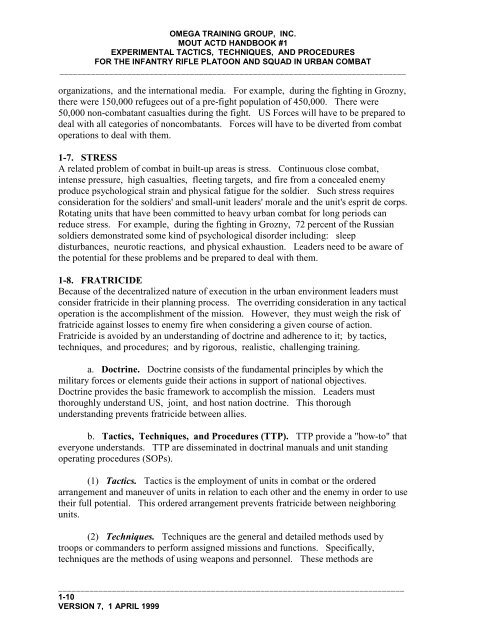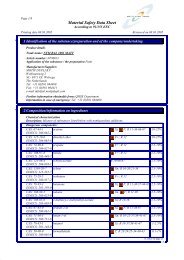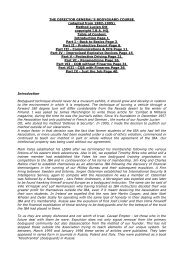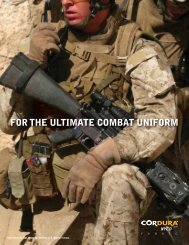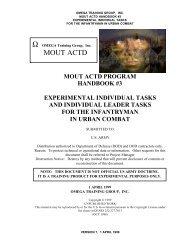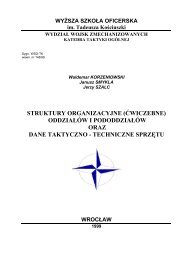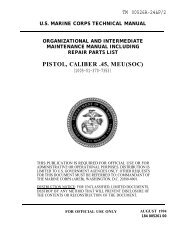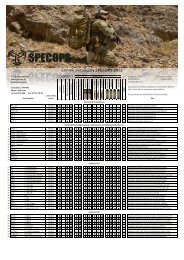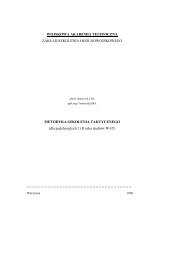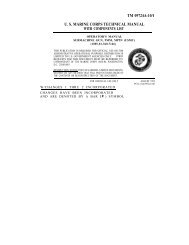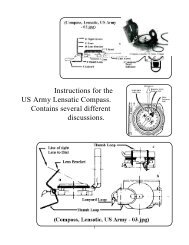mout actd program handbook #1 experimental tactics ... - SpecOps
mout actd program handbook #1 experimental tactics ... - SpecOps
mout actd program handbook #1 experimental tactics ... - SpecOps
Create successful ePaper yourself
Turn your PDF publications into a flip-book with our unique Google optimized e-Paper software.
OMEGA TRAINING GROUP, INC.<br />
MOUT ACTD HANDBOOK <strong>#1</strong><br />
EXPERIMENTAL TACTICS, TECHNIQUES, AND PROCEDURES<br />
FOR THE INFANTRY RIFLE PLATOON AND SQUAD IN URBAN COMBAT<br />
_____________________________________________________________________________<br />
organizations, and the international media. For example, during the fighting in Grozny,<br />
there were 150,000 refugees out of a pre-fight population of 450,000. There were<br />
50,000 non-combatant casualties during the fight. US Forces will have to be prepared to<br />
deal with all categories of noncombatants. Forces will have to be diverted from combat<br />
operations to deal with them.<br />
1-7. STRESS<br />
A related problem of combat in built-up areas is stress. Continuous close combat,<br />
intense pressure, high casualties, fleeting targets, and fire from a concealed enemy<br />
produce psychological strain and physical fatigue for the soldier. Such stress requires<br />
consideration for the soldiers' and small-unit leaders' morale and the unit's esprit de corps.<br />
Rotating units that have been committed to heavy urban combat for long periods can<br />
reduce stress. For example, during the fighting in Grozny, 72 percent of the Russian<br />
soldiers demonstrated some kind of psychological disorder including: sleep<br />
disturbances, neurotic reactions, and physical exhaustion. Leaders need to be aware of<br />
the potential for these problems and be prepared to deal with them.<br />
1-8. FRATRICIDE<br />
Because of the decentralized nature of execution in the urban environment leaders must<br />
consider fratricide in their planning process. The overriding consideration in any tactical<br />
operation is the accomplishment of the mission. However, they must weigh the risk of<br />
fratricide against losses to enemy fire when considering a given course of action.<br />
Fratricide is avoided by an understanding of doctrine and adherence to it; by <strong>tactics</strong>,<br />
techniques, and procedures; and by rigorous, realistic, challenging training.<br />
a. Doctrine. Doctrine consists of the fundamental principles by which the<br />
military forces or elements guide their actions in support of national objectives.<br />
Doctrine provides the basic framework to accomplish the mission. Leaders must<br />
thoroughly understand US, joint, and host nation doctrine. This thorough<br />
understanding prevents fratricide between allies.<br />
b. Tactics, Techniques, and Procedures (TTP). TTP provide a "how-to" that<br />
everyone understands. TTP are disseminated in doctrinal manuals and unit standing<br />
operating procedures (SOPs).<br />
(1) Tactics. Tactics is the employment of units in combat or the ordered<br />
arrangement and maneuver of units in relation to each other and the enemy in order to use<br />
their full potential. This ordered arrangement prevents fratricide between neighboring<br />
units.<br />
(2) Techniques. Techniques are the general and detailed methods used by<br />
troops or commanders to perform assigned missions and functions. Specifically,<br />
techniques are the methods of using weapons and personnel. These methods are<br />
_____________________________________________________________________________<br />
1-10<br />
VERSION 7, 1 APRIL 1999


